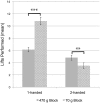Twelve-month-old infants anticipatorily plan their actions according to expected object weight in a novel motor context
- PMID: 25756040
- PMCID: PMC4337204
- DOI: 10.3389/fpubh.2015.00032
Twelve-month-old infants anticipatorily plan their actions according to expected object weight in a novel motor context
Abstract
Planning actions in anticipation of object weight is fundamental to skilled action production. The present study investigated whether infants can apply weight information gained from direct actions on objects in order to plan their actions according to object weight in a novel and indirect motor context. In the present study, two groups of 12-month-old infants were provided with experience acting directly on two blocks of different weights and colors (70 versus 470 g; red versus yellow). Subsequently, infants were administered a novel task in which the same blocks (standard condition; n = 60), or blocks of the reversed color-weight pairings (switch condition; n = 60), were placed out-of-reach, on top of a cloth, and infants were encouraged to retrieve the block by acting on the cloth. Infants in the switch condition produced more failed cloth pulls when retrieving the 470 g block, due to inadequate generation of anticipatory force, relative to infants in the standard condition. This demonstrates that infants' force on the cloth was prospectively generated based on their mental representation of the supported block's weight, which was formed through their previous direct actions on the object. Thus, infants use information about the weight of an object in order to anticipate how to obtain that object in a novel and indirect problem-solving context.
Keywords: action planning; infancy; motor adaptation; motor inference; weight perception.
Figures


References
-
- Molina M, Jouen F. Weight perception in 12-month-old infants. Infant Behav Dev (2003) 26(1):49–6310.1016/S0163-6383(02)00168-6 - DOI
-
- Palmer CF. The discriminating nature of infants’ exploratory actions. Dev Psychol (1989) 25(6):885.10.1037/0012-1649.25.6.885 - DOI
-
- Gordon AM, Westling G, Cole KJ, Johansson RS. Memory representations underlying motor commands used during manipulation of common and novel objects. J Neurophysiol (1993) 69(6):1789–96. - PubMed
Grants and funding
LinkOut - more resources
Full Text Sources
Other Literature Sources

